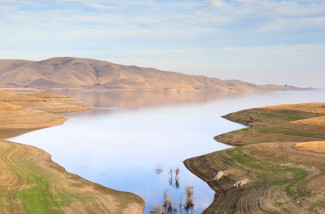
Johns Hopkins UniversityEst. 1876
America’s First Research University
Water Resources: Science and Society

Water scarcity affects four of 10 people around the globe. Ninety percent of all natural disasters are water-related. The year is 2019, and we live in a highly connected world with endless technology at our fingertips, yet more than two billion people lack access to safely managed drinking water services. The result: hundreds of thousands of children under five die every year from diarrheal diseases. Our water challenges are not restricted to household use. Energy production often requires large amounts of water, and agriculture accounts for 70% of global water withdrawals. Energy and food production are highly dependent on the withdrawal and consumption of water—more often than not, the withdrawal and consumption of the same water vital to sustaining our ecosystems.
Yet, it is not all doom and gloom. There is room for optimism, but to move us toward sustainable development, we need to understand how much water there is on earth, and how it is distributed over space and time. We need to understand how much water humans need, and how much water the environment needs. In the face of a changing climate, understanding the foundations of water supply and demand is a critical first step to moving us towards sustainability and finding solutions to meet water resource challenges.
Water Resources: Science and Society provides examples of real-world water scarcity challenges and tradeoffs so that the nuances of each place can be integrated into solutions. Managing water resources is something that all countries, whether at a high level of economic development or moving from a relatively underdeveloped status toward improved living conditions, must face. When water is insufficient to maximize all the demand objectives—either because of low water availability or low water quality—trade-offs are made to allocate water. While the fundamental challenges may be similar—provide adequate and reliable water of relevant quality to water users—the solutions are likely nuanced.

As just one comparison, we can take Los Angeles in the United States and Nairobi in Kenya. The Los Angeles Department of Water and Power supplies 3.9 million people at an average rate of more than 400 liters per capita per day, with essentially all homes having piped water. The Nairobi City Water and Sewerage Company in Kenya supplies about half of the population of 3.8 million people by piped water at an average rate of about 140 liters per capita per day; this accounts for the estimated 50% leakage from pipes.
We explore the future tradeoffs for the two locations, which differ starkly. Los Angeles anticipates a small growth in population and essentially little to no increase in demand for water by 2035. Nevertheless, changes are required to meet sustainability goals given projected changes in climate. In contrast to Los Angeles, the population of Nairobi is expected to double by 2035. Urban water supply will need to more than double to meet the increased population and provide water to those previously not connected to the municipal system. This will require strategic planning to balance other water demands, such as for sustaining local ecosystems and producing power.
Solutions to meet the aforementioned challenges differ as starkly as the tradeoffs for the two cities. For Los Angeles, plans include capturing local storm-water runoff for use, increasing recycled water availability, and instituting advanced conservation measures. In Kenya, the notion of developing rules to guide the implementation of water management options persists, but overcoming the economic burdens of delivering an adequate supply of safe water to all is likely a central component of future solutions.
Our goal in Water Resources: Science and Society is to provide students with the knowledge required to make the first step towards sustainability and solutions. Our book is unique from other textbooks in that we bridge water supply, demand, and management. We integrate quantitative calculations to estimate water budgets and water requirements for energy, with qualitative think-pieces and case studies that illustrate key principles of water law. Water underpins all aspects of development, and Water Resources highlights the tradeoffs we face in allocating our water resources. These tradeoffs have implications for green growth, sustainable economies, and reliable resource supply, so whether your student plans to use the course to initiate their career in hydrology, water resources engineering, water law, etc. or to use the course as an elective, the textbook contents are likely applicable and relevant.
George M. Hornberger is a University Distinguished Professor at Vanderbilt University, where he is the director of the Institute for Energy and Environment. He is a coauthor of Elements of Physical Hydrology. Debra Perrone is an assistant professor within the Environmental Studies Program at the University of California, Santa Barbara. Together, Hornberger and Perrone are the authors of Water Resources: Science and Society.


